- Учителю
- Конспект урока Урок - показ мод
Конспект урока Урок - показ мод
Урок - показмод
в 8 классе
Тема:
What Do You Know About Fashion?
Апрель, 2008 год.
Учитель: Копцева Ольга Васильевна
Цели урока:
1. Развивать у учащихся способность монологически и диалогически высказываться по теме урока и давать свою оценку, разбираться в стилях и направлениях современной моды, быть активными, изобретательными.
2. Воспитывать культуру внешнего вида.
Оснащение урока: Картинки, фотографии из истории моды, костюмы, фотографии известных дизайнеров - Кутюрье, куклы в русских народных костюмах, аудиозаписи мелодий, карточки со словами, рисунки детей, журнал"Speak Out, карточки с заданиями, фотографии представителей уличных стилей молодежной моды.
Ход урока:
1. Речевая зарядка. Приветствие.
Teacher: What is the weather today? What have you got on? What do people wear in April? By the way, what holiday is it today? Yes, today is the 23rd of April, William Shakespeare's Birthday. And do you know what people wore in Shakespeare's time? Look at this picture. So, you see they wore …… .

</<br>




Today we'll have an unusual lesson about fashion. Fashion plays a great role in your life. You want to be attractive and your clothes express your individuality. But to be really attractive and well-mannered you should know when and where to wear this or that style or clothes.
2. Развитие диалогической речи.
Teacher: Now you express your opinions about what you wear.
P1 - P2: - If I were you I would wear something else.
-
Why?
-
I think your clothes are too extravagant.
-
My clothes express my feelings.
-
What is important for you in clothing?
-
To feel comfortable in. I prefer clothes which are classical in design. What do you prefer to wear?
-
I adore waistcoats.
-
They are back nowadays. They are again fashionable.
3. Аудирование.
a) Teacher: Now some riddles about clothes:
-
This thing is used to decorate your blouse or dress. Your clothes look smart and beautiful with this thing. But it is not used in teenage fashion.
-
It is a kind of footwear. It is necessary especially for those people who go in for sports.
-
You put it when it is cold. It can be hand-made or machine-made. It is usually made of wool. It's very popular among teenagers.
-
You put them at home. They are warm and comfortable. They are usually made of leather wool or felt.
b) Find missing words:
-
boots, sandals, trainers, shirts.
-
sweater, pullover, suit, cardigan.
-
raincoat, jacket, kilt, fur coat.
-
embroidery, clothes, outfit, costume.
-
silk, cotton, gold, nylon.
-
earrings, bracelets, glasses, chains.
-
sarafan, caftan, bast- shoes (лапти), baseball-cap.
-
socks, stockings, shorts, tights.
c) ex. 1, 2, p. 167.
1) listening, 2) reading, 3) And what do you think about fashion?
4. Развитие монологической и диалогической речи учащихся. Основная часть урока.
Teacher: We are going to talk about history of the 20th Century fashion in brief. Let's begin our show with the description of Russian national costume. In different parts of Russia it varied. Look at these beautiful dolls. Please, what can you tell the class about their costumes?
Girl: Women and girls wore long wide sarafans, decorated with lace and frills, light blouses with long sleeves, underneath skirts, lapties on feet. They often had aprons with embroidery and lace. Besides girls wore high kokoshniks decorated with colored ribbons. They usually had long plaits, and they decorated themselves with necklaces and earrings.
Boy: Men and boys usually wore long-sleeved shirts decorated with embroidery or lace and a long wide belt. Then they had wide trousers called 'sharovari', lapties. On their heads they wore hats or caps.


P1: Before the First World War fashions didn't change very quickly. Men wore dark suits. They had short hair and moustaches were very popular. Women wore long dresses and they had long hair.
In the Roaring Twenties dresses and hair became much shorter. People saw women's knees for the first time. A straight figure with no waist was fashionable. For men trousers with very wide legs became fashionable. They were called Oxford bags.
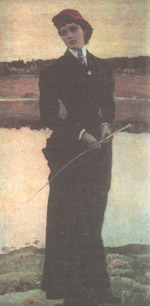
In the 1930 and 40s hair, dresses and coats became longer again. Men wore a shirt, a tie and usually a hat, too. Moustaches were less popular.


P2: In the 1950s people were richer and teenagers spent a lot of
money on clothes. For men it was age of teddy boy. Teddy boys wore
long jackets in very bright colors - pink, orange or yellow - and
very tight trousers. Women wore jumpers and blouses with wide
skirts and short socks. Both men and women wore shoes with long
pointed toes. The women's shoes had high stiletto heels. 
The 1060s saw a revolution in clothes. Everything changed. This was time of mini-skirt and long boots. Men had long hair - the famous Beatles haircut.

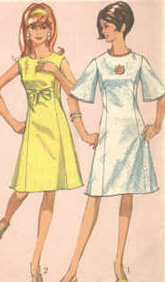
P3: In the late 1960s and early 70s the "flower-power" style was in. Men wore jeans and brightly shirts or T-shirts. Clothes were very colorful. Very long hair was fashionable for men and women, and bears became more common.
The 80-s brought teenagers with punk hair styles in red, blue, purple and green and brightly colored make-up.


P4: In 1970s the clothes of men's fashion came to
women's wardrobes. It was a costume, practical and firm and it
became a favorite sort of clothes among progressive business women.
It was a combination of a jacket and trousers, a jacket and a skirt
or a waist-coat and trousers or a skirt. These clothes were
comfortable and served your movements , habits or a gait. They
Showed discipline, strictness and freedom at the same time.
Business clothes mustn't be boring. Clean, light and delicate
colors are all right. A white or a light blouse or shirt will
always decorate your business  costume for a special event or a
visit.
costume for a special event or a
visit.
Teacher: America has created its own type of clothing, which is now popular all over the world. The best invention is jeans, which has become an icon of American culture.
P5: Blue jeans were a by-product of the Gold Rush. The man who
invented jeans Levi Strauss, emigrated from Germany to san
Francisco in 1850. Levi was 20 years old and he decided to sell
clothes to the miners in California. He began making jeans of heave
tent canvas. Levi's jeans were an immediate success. Soon he bought
a fabric that was softer than canvas from Nimes, a city in France.
The miners liked the fabric. They called it 'denim'. Strauss dyed
the denim blue. Today the company he started is known all over the
world. 

P6: The next invention is T-shirts. They started off as underwear.
During the First World War European soldiers wore them
underneath their uniforms to keep warm. American troops copied the
idea and started calling them "T-shirts" because of their t shape.
In the mid 50s actor James Dean and rock star Elvis Presley shocked
the world by wearing their T-shirts on TV. It was too much for
young people to ignore. Everyone wanted to look like James Dean and
Elvis Presley. Today T-shirts are worn by babies, kids, teenagers,
adults. 

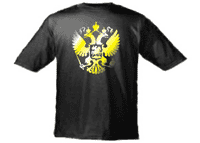

Teacher: What about shoes? Are they fashionable?
P7: What is expensive and good for your feet? Trainers, of course. Trainers are not like other shoes. Good trainers stay with the natural shape of your feet. Doctors say it's good for your feet to wear no shoes at all. Parents have been complaining about the cost of their children's shoes. Teenagers don't want to buy ordinary trainers from shoe shops now. Everyone wants to buy 'designer trainers'. The most popular trainer companies in Britain are Nike, Reebok, LA, Puma and Hi-tech. Now trainers are stronger, lighter, more comfortable. They help you with your sport. They are so cool!
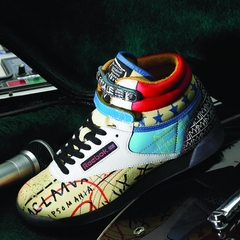
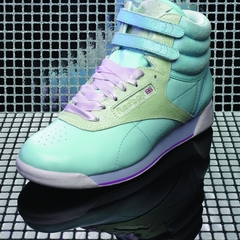

Teacher: So, teenagers don't like formal clothes. But official style is normal at work, at school, and high fashion is demanded at the parties. Let's have a talk about high fashion in Russia.
P8: Look at this photo: This man has got international recognition in the haute couture world. His name is Valentin Yudashkin. He said about his roots: "I'm terribly Russian. I'm trying to make the beauty of Russian culture." He was born near Moscow in 1963. He showed his first collection in Russia in 1987. In 1991 he began doing haute couture runway shows in Paris. His collections were called "Faberge", "Music", "Still life", "Frescos", "Catherine the Great" and "Ballet", "Bridges of Paradise". Many of his collections were inspired by the music of Tchaikovskiy, Rakhmaninov, Glinka. Nearly all his life he has been studying the Russian costume. He opens his couture house in Moscow in 1993. In 1997 Yudashkin became the member of the French fashion governing body. He said: "I'm Russian, but the capital of fashion is Paris".

Teacher: So, you see, our country is rich in talented people. Maybe, there are future Yudashkins among you, because you are going to show us a collection of a new school uniform of the future. The designers of this collection are…… . You are welcome!
P1-P5: This is my model of a new school uniform. It is modern in design and comfortable to wear. It consists of …… . You have never seen anything better!
Teacher: Thank you very much. Whose models did you like best? Why?
Nowadays there are many special styles we can see in the streets of towns and cities. What do you know about them?
P9: I want to tell you about one style which is very special. Look at this picture with a young man dressed in a shocking way to express his individuality. He has brightly colored hair and wears metal chains. His manner of clothing expresses protest against society. His music is aggressive. He rejects everything.
Teacher: Is this fashion pleasant?
PP: Yes, it is.
Teacher: How is it called?
PP: It's a punk style.
Teacher: Can they work in an office, company, plant, or can they attend classes?
PP: No, they can't, it's a street style.
Teacher: Choose the correct variant:
1. Punks usually had…… ,
a) their hair long b) brightly-dyed hair
c) their hair long with lots of color threads in it
2. Punks usually wore…… .
a) silver earrings b) lots of rings, bracelets and bells
c) they pursed their noses and ears with pins
3. Hippies wore…… .
a) long robes or dresses and flares
b) old black denim jeans c) old clothes
4. New Age Travelers wore …… .
a) scruffy clothes b) extravagant dresses
c) old clothes
5. Hippies loved to wear…… .
a) wooden clogs b) sandals c) trainers
Teacher: What other subculture fashion can you tell us about today?
P10: I'd like to tell you about Emos. Look at these photos. You can recognize them by black and pink narrow ripped jeans, T-shirts with cartoon characters on them, bracelets, different headbands, plush rucksacks or handbags decorated with skulls or hearts. They usually have a lot of badges in different places. Their haircut is usually a ragged bang which covers one eye. Emos are usually thin and their nails are also black.
Teacher: Thank you. Now you can differ one style from the other and you know exactly what sort of your clothes you should wear in this or that situation. I hope you will always be attractive and well-mannered.
Our lesson is over. Thank you for your active work at the lesson. You will have 5s and 4s for today. Good luck.
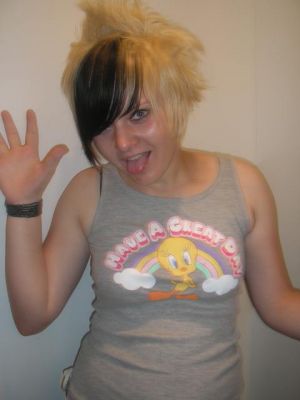





Choose the correct variant:
1. Punks usually had…… ,
a) their hair long b) brightly-dyed hair
c) their hair long with lots of color threads in it
2. Punks usually wore…… .
a) silver earrings b) lots of rings, bracelets and bells
c) they pursed their noses and ears with pins
3. Hippies wore…… .
a) long robes or dresses and flares
b) old black denim jeans c) old clothes
4. New Age Travelers wore …… .
a) scruffy clothes b) extravagant dresses
c) old clothes
5. Hippies loved to wear…… .
a) wooden clogs b) sandals c) trainers
Choose the correct variant:
1. Punks usually had…… ,
a) their hair long b) brightly-dyed hair
c) their hair long with lots of color threads in it
2. Punks usually wore…… .
a) silver earrings b) lots of rings, bracelets and bells
c) they pursed their noses and ears with pins
3. Hippies wore…… .
a) long robes or dresses and flares
b) old black denim jeans c) old clothes
4. New Age Travelers wore …… .
a) scruffy clothes b) extravagant dresses
c) old clothes
5. Hippies loved to wear…… .
a) wooden clogs b) sandals c) trainers

